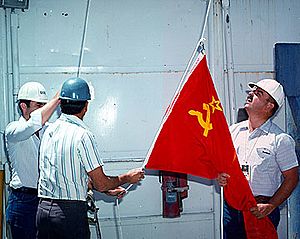Operation Touchstone facts for kids
Quick facts for kids Touchstone |
|
|---|---|
| Information | |
| Country | United States |
| Period | 1987–1988 |
| Number of tests | 13 |
| Test type | underground shaft, tunnel |
| Max. yield | 150 kilotonnes of TNT (630 TJ) |
The United States's Touchstone nuclear test series was a group of 13 nuclear tests carried out by the United States between 1987 and 1988. These tests were done underground to help develop and improve nuclear weapons, and also to conduct safety experiments. This series of tests happened after the Operation Musketeer series and before the Operation Cornerstone series.
A very important part of the Touchstone series was the Touchstone Kearsarge test. This was a special joint test with the Soviet Union, called the Joint Verification Experiment (JVE).
What was the Joint Verification Experiment?
The Joint Verification Experiment (JVE) was a big step in building trust between the United States and the Soviet Union during the Cold War. Both countries had many nuclear weapons. They wanted to make sure each side was following agreements to limit the size of their nuclear tests.
Why was the JVE important?
The main goal of the JVE was to check if both countries were sticking to the Threshold Test Ban Treaty. This treaty limited the power, or "yield," of underground nuclear tests. To do this, scientists from both countries visited each other's nuclear test sites.
For the Touchstone Kearsarge test, Soviet scientists were present at the American test site in Nevada. They watched the test and collected data. This helped both sides learn how to accurately measure the size of nuclear explosions from far away. It was a way to verify, or check, that no one was secretly breaking the treaty. The image shows a Soviet flag being raised next to an American flag at the test site, symbolizing this cooperation.


